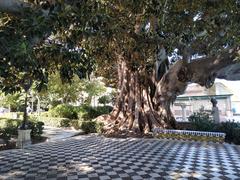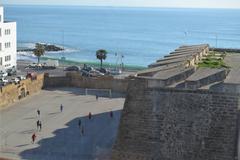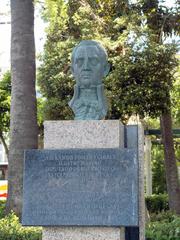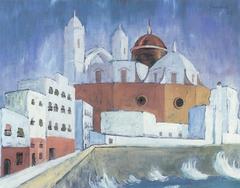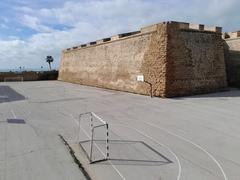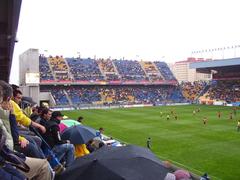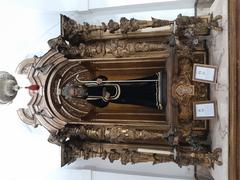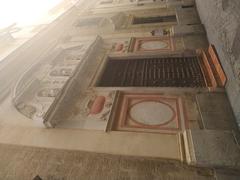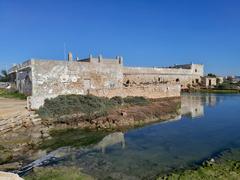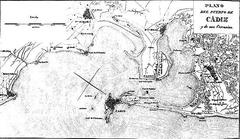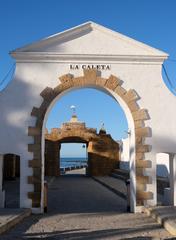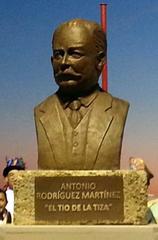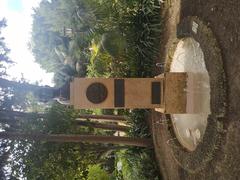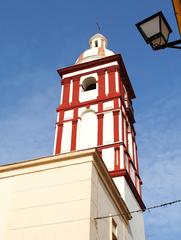Roman Theatre of Cádiz: Visiting Hours, Tickets, and Historical Significance
Date: 03/07/2025
Introduction
The Roman Theatre of Cádiz, located in the heart of the El Pópulo district, stands as one of Spain’s most extraordinary archaeological treasures. Built around 70 BCE under the patronage of Lucius Cornelius Balbus “the Elder” and his nephew, this monument offers a profound glimpse into Cádiz’s ancient past as a flourishing Roman port and cultural hub. Today, visitors can explore its remarkable architectural remains, engage with interactive exhibits at the interpretation center, and immerse themselves in the vibrant history and culture of Cádiz (Oway Tours; Barceló Guide).
Table of Contents
- Introduction
- Origins and Construction
- Role and Significance in Roman Gades
- Architectural Features and Discoveries
- Decline and Rediscovery
- Practical Visitor Information
- Interpretation and Visitor Experience
- Preservation Efforts
- Travel Tips
- Frequently Asked Questions (FAQ)
- Conclusion
- References
Origins and Construction
The Roman Theatre of Cádiz, also known as Theatrum Balbi, was constructed circa 70 BCE during the city’s expansion as Gades—the Roman name for Cádiz. Commissioned by the powerful Balbo family, close allies of Julius Caesar, the theatre became a central venue for social, cultural, and civic life. Its construction was part of a broader urban renewal, which included an amphitheater and other public works that signaled Cádiz’s prominence within the Roman Empire (Oway Tours; Barceló Guide).
Strategically integrated into the natural hillside of El Pópulo, the horseshoe-shaped cavea (auditorium) could seat over 10,000 spectators, making it the oldest known Roman theatre in Spain and one of the largest in Hispania (Fascinating Spain; Betica Romana).
Role and Significance in Roman Gades
Gades was originally a Phoenician settlement before rising as a significant Roman port after 206 BCE. The theatre reflected the city’s affluence and Romanization, serving as a venue for performances, civic ceremonies, and religious festivities. Its grand scale and architectural sophistication signaled Gades’s integration into Roman urban culture, and it was even mentioned by classical writers such as Cicero and Strabo (Tourist Platform; Wikipedia).
Architectural Features and Discoveries
Site Layout
The Roman Theatre’s design combines Greek and Roman influences: a horseshoe-shaped cavea carved into the hillside, barrel-vaulted galleries, and an orchestra pit at the base. The scaenae frons (stage façade) was once decorated with columns, niches, and statues, reflecting the artistic sophistication of Roman Cádiz (Betica Romana; Fascinating Spain).
Discoveries
Excavations begun in 1980 uncovered portions of the cavea, orchestra, and vaulted galleries—though much of the stage remains buried beneath the city. Artifacts such as marble cornices, frieze fragments, and columns are displayed at the Cádiz Museum (academia-lab.com).
Decline and Rediscovery
Abandoned by the late 3rd century CE due to urban shifts and empire-wide decline, the theatre’s stones were repurposed over the centuries. Medieval structures, including the Castle of the Theatre, were built atop its remains. Rediscovered in 1980, its excavation revealed invaluable insights into Cádiz’s stratified urban history (academia-lab.com; alsherry.com).
Practical Visitor Information
Opening Hours
- Typical hours: 10:00 AM to 6:00 PM (last entry 5:30 PM)
- Closed: Mondays and certain public holidays
- Tip: Check official tourism resources for updates, especially during holidays or special events.
Tickets and Admission
- Admission: Free for all visitors
- Guided tours: May require booking; check with the Gades Roman Theater Interpretation Center
How to Get There
- Location: Calle Mesón, El Pópulo district, Cádiz
- Access: Easily reachable on foot from the city center and major landmarks (e.g., Cádiz Cathedral)
- Transport: Public buses, taxis, and paid parking nearby
Guided Tours and Accessibility
- Guided tours: Offered regularly; private guides can be arranged for in-depth experiences
- Accessibility: Site is generally wheelchair accessible, though some uneven surfaces remain
Special Events and Photography
- Events: Occasional open-air performances, workshops, and community programs
- Photography: Encouraged; the theatre offers dramatic cityscape views
Nearby Attractions
- Cádiz Cathedral
- Torre Tavira (panoramic city views)
- La Caleta Beach
- Museum of Cádiz
- Plaza de San Juan de Dios
- Barrio del Pópulo (historic neighborhood with cafes and tapas bars)
Interpretation and Visitor Experience
The Gades Roman Theater Interpretation Center enhances the visitor experience with:
- Explanatory panels and models illustrating the theatre’s original appearance and construction techniques
- Archaeological wells and stratigraphic displays revealing centuries of urban evolution
- Audiovisual resources on theatre history and excavations
- Artifacts including marble fragments and decorative elements from Roman Cádiz (academia-lab.com)
The center also highlights the theatre’s connection to the influential Balbo family and the broader context of Roman urbanism in Hispania (alsherry.com).
Preservation Efforts
The Roman Theatre of Cádiz is a focal point for ongoing archaeological research and conservation. Urban integration, protective coverings, and controlled visitor access help preserve the remains. Artifacts are safeguarded in the Cádiz Museum, and community engagement through educational programs ensures the site remains a living part of the city’s identity (alsherry.com).
Travel Tips
- Visit early or late in the day for fewer crowds and better lighting for photos
- Wear comfortable footwear due to uneven surfaces
- Check for guided tour times at the interpretation center
- Combine your visit with a self-guided walking tour of Cádiz’s Old Town
- Bring water in warmer months
Frequently Asked Questions (FAQ)
Q: What are the Roman Theatre of Cádiz visiting hours?
A: Daily, 10:00 AM to 6:00 PM (last entry 5:30 PM), closed Mondays and some holidays.
Q: Is there an entrance fee?
A: Admission is free; guided tours may require a reservation.
Q: Is the site wheelchair accessible?
A: Most areas are accessible, but some uneven surfaces remain due to the ruins.
Q: Are guided tours available?
A: Yes, through the interpretation center; private guides are also available.
Q: What other sites are nearby?
A: Cádiz Cathedral, Torre Tavira, La Caleta Beach, Museum of Cádiz, and Barrio del Pópulo.
Conclusion
The Roman Theatre of Cádiz is a must-visit destination for anyone interested in Roman history, architecture, or the layered heritage of Cádiz. With its free admission, central location, and engaging interpretation center, it offers a unique opportunity to walk through ancient history in a vibrant modern city. Plan your visit to coincide with a guided tour or special event, and take time to explore the surrounding El Pópulo neighborhood for a truly immersive experience.
For the latest updates on visiting hours, tickets, and events, consult official Cádiz tourism resources and consider downloading the Audiala app for enriched content and interactive guides. Experience the echoes of Roman civilization in one of Spain’s most captivating archaeological landmarks.
References and Further Reading
- Oway Tours
- Fascinating Spain
- Academia Lab
- Visit Andalucia
- Betica Romana
- Visiting Cádiz
- Alsherry
- Roman Empire Architecture
- Nomads Travel Guide
- Tourist Platform
- TripHobo
- Wikipedia
